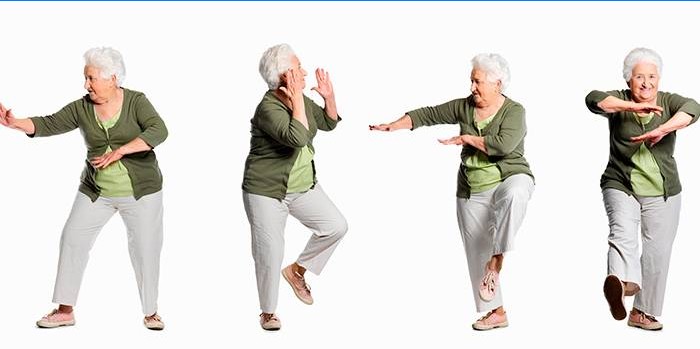The content of the article
With age, all processes in the body slow down. The biological aging of the body occurs individually in everyone. It depends on many factors – genetics, lifestyle, nutrition, etc. Determine the rate of aging using simple tests. They will show which body systems require adjustment, what needs to be done to improve results..
Do you face premature aging
Age-related changes are often accompanied by chronic pain during movement, impaired coordination, or decreased muscle strength. A person is dizzy with a sharp change of body, which increases the risk of falling, fractures or bruises. This significantly affects the quality of life of people of middle or old age. The results of simple tests will show whether a person is facing premature aging or at what stage. The data obtained will reveal what needs to be done for prevention.
Balancing test

Eyes visually determine the position of the body in space. Then, the organs of vision transmit a signal to the brain, which sends an impulse to the muscles and joints. This is the movement. If a person cannot control the body, this indicates the onset of aging.
The inner ear is involved in the balancing process. Its channel is filled with fluid that sends signals to the brain about the position of the head. If the limb moves, then the nervous system determines the direction. This mechanism is called internal orientation in space. The balancing test takes 1-2 minutes. An assistant is required who will mark the results or prevent a fall.
How to test:
- Stand barefoot on the hard floor.
- close your eyes.
- Ask an assistant to check the time.
- Raise your left leg, bending at the knee – for righties. Lefties need to tear off the right limb from the floor.
- Keep your foot at a height of 15 cm from the surface.
- Lower your arms along your body. Stand steady without staggering.
- Stop the time when the foot touches the floor or the person raises his hands, opens his eyes.
- Repeat the test 3 times. Then add all the results and divide by 3. This will be the average balancing time.
Normal indicators by age:
- 40 years – 16 seconds;
- 50 to 9;
- 60-7;
- 70 – 4.
Muscle strength test

The next test is for exercising your lower body or arms. These are the muscles of the hips, back, or limbs. The test results indicate the level of coordination, balancing and strength of the lower body. These indicators will help identify the risk of a fall in the future..
If everything goes well, you can not worry about premature aging of the body. Scientists consider the positive result as evidence that the chances of losing motor activity early are 50% less than those who did not pass the test..
How to conduct a study:
- Sit on the floor, legs and back straight.
- Try to get up without using your hands or surrounding objects..
There is a second option for testing muscle strength:
- Sit on a chair with your feet on the floor.
- Take the dynamometer in your hand. This is a force meter..
- Squeeze it tightly for 3 seconds.
The strength of compression shows how quickly the body ages. If the arm muscles are strong, the rest of the body also works fine.
Dynamometer test average:
- women 50 years old – 28 kg;
- men – 44;
- women 60 years old – 24 kg;
- men – 40.
Dynamic test

The aging of the body begins when a person loses the ability to move quickly. You can determine this with a simple test..
What to do:
- Sit in a chair, relax.
- Prepare a stopwatch. Turn it on when you start to rise.
- Stand up, quickly walk forward about 3 meters.
- Turn around your axis, go into place.
- Take time to sit in a chair.
An adult, healthy person does the job in 10 seconds or less. If the exercise took longer or dizzy, you should exercise.
What to do

- Walk from heel to toe to train your vestibular apparatus.
- Stand on one leg if balancing test results are not comforting.
- Eat more red grapes, cranberries or peanuts. They contain resveratrol, which will help slow down the aging of the body..
- Visit the gym 2 times a week, focusing on exercises for developing muscles, ligaments of the ankles, knees and back, if you cannot get up from the floor without arms.
- If the results of the dynamometer press are less than normal, work with the device in the morning and evening.
- The dynamic test is corrected through continuous training to improve coordination..
Examples of exercises:
- In a standing position, hands on the waist, move your left leg to the side. Hold it for 5 seconds. Return to starting position. Repeat the exercise with the right foot. Do it 10 times.
- Standing level, press your feet to one another. Cross your arms over your chest. Close your eyes. Stand as long as you can.
- Complement the previous exercise with a bend in the knee. Place your raised foot on the inside of the supporting limb. Repeat the exercise for both legs 10 times.

These 3 tests to determine your body’s age seem interesting. Can you provide more details on what these tests are and how accurately they can determine one’s age?
What are the three tests to determine the age of one’s body? Are these tests accurate in assessing the actual age of the body? Can they help identify potential health concerns related to aging? How frequently should these tests be performed to monitor changes in the body’s age?